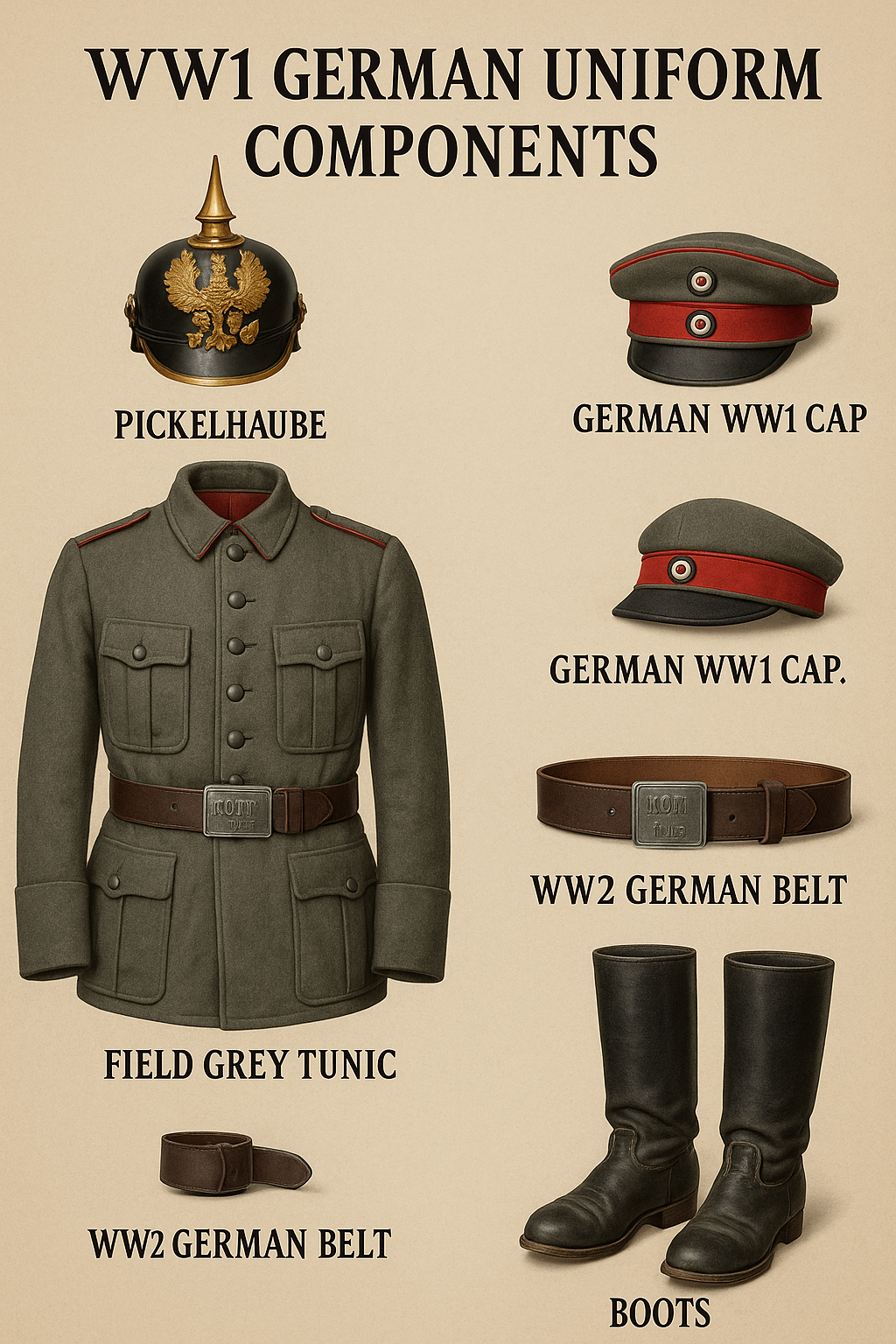
Essential WW1 German Uniform Parts: Helmets, Belts, Caps & More
Published on Jul 20, 2025
✅ Meta Tags
Meta Title:
WW1 German Uniform Components – Full Breakdown of Military Gear & Accessories
Meta Keywords:
WW1 German uniform components, german ww1 cap, ww2 german belt, austro hungarian helmet ww1, ww1 russian helmet, german army uniforms
Meta Description:
Explore the key components of WW1 German uniforms. Learn about the german ww1 cap, ww2 german belt influence, helmets, tunics, and how to pick accurate reproductions with expert tips.
Summary:
Dive deep into the essential components of WW1 German military uniforms. This detailed guide highlights key elements such as tunics, belts, helmets, and caps, offers comparisons with other WW1 and WW2 gear, and helps readers find authentic reproductions through trusted resources.
🪖 WW1 German Uniform Components: A Full Breakdown of History, Function & Style
If you’re searching for authentic WW1 German uniform components—whether for reenactments, collecting, cosplay, or educational purposes—you’ve landed on the perfect page. We’ll cover each piece that made up the legendary Imperial German uniform: from the German WW1 cap to the iconic Pickelhaube helmet and the field tunic, all the way down to belts and boots.
By the end of this guide, you’ll not only recognize each item but also understand its significance in military history—and where to buy authentic, high-quality reproductions.
📜 Table: Key WW1 German Uniform Components
ComponentDescriptionMaterial UsedModern Usage Pickelhaube Helmet | Spiked leather helmet for ceremonial and early combat use | Leather & brass | Popular with collectors
Field Grey Tunic (Bluse) | Standard infantry wool tunic, dyed in Feldgrau color | Wool | Used in reenactments
German WW1 Cap (Feldmütze) | Soft cap with red piping worn by enlisted men | Wool & cotton blend | Symbolic in military fashion
WW2 German Belt | Derived from WW1 designs; used for ammunition pouches | Leather | Still recreated for uniform reenactors
Shoulder Straps & Insignia | Rank and unit designation shown with cloth insignia | Colored thread/wool patches | Important for accurate reproduction
Boots (Marschstiefel) | Tall leather marching boots | Leather | Recreated for full uniform sets
🎩 The German WW1 Cap – A Signature Look of the Imperial Army
The German WW1 cap, or Feldmütze, was worn by enlisted soldiers and junior officers. Its key features included:
- A soft, foldable shape for convenience
- Red piping around the crown
- Two cockades: one national, one state-specific
Even today, this cap remains a favorite among WW1 reenactors. For those aiming for historical accuracy, it’s worth checking out our detailed advice in Top Tips for Choosing the Perfect Imperial German Uniform Reproduction.
🧥 Field Tunics & the Evolution of the German Soldier’s Wardrobe
The Bluse, or field tunic, was dyed in Feldgrau to blend with the battlefield. It had six buttons and external pockets, combining utility with militaristic style. Officers often had theirs tailored, while enlisted men received standard-issue versions.
Interestingly, many of these features were carried over into WW2. If you compare a WW1 tunic to what’s now called the WW2 German Army Uniform, you’ll spot continuity in design and function—visible in our full WW2 Uniform Collection.
🧍 The Influence of the WW2 German Belt on WW1 Design
While the WW2 German belt is typically recognized for its use with ammo pouches and sidearms, its roots are in WW1 design. The original belt:
- Was made of thick leather
- Supported cartridge boxes
- Included a rectangular buckle often inscribed with "Gott Mit Uns"
These belts became symbols of German resilience and are often used across WW1 and WW2 reenactments. Learn more about these transitions in The Fascinating History of German Army Uniforms.
🪖 Helmets Compared: German Pickelhaube vs Austro-Hungarian and Russian WW1 Helmets
📊 Table: Comparative Helmets of WW1
HelmetNationMaterialUnique FeaturePickelhaube | Germany | Leather/metal | Brass spike on top
Austro Hungarian Helmet WW1 | Austro-Hungarian | Steel | Sloped design, often camouflaged
WW1 Russian Helmet | Russia | Steel | Broad brim, heavily padded interior
The Pickelhaube, though iconic, became less practical during trench warfare, which prompted Germany to later adopt the Stahlhelm. Meanwhile, countries like Austria-Hungary used steel helmets like the Berndorfer, and Russia developed simpler, broader helmets.
Understanding these differences is crucial for historical education and authenticity in reenactments.
🧵 How to Assemble an Accurate WW1 German Uniform
If you're looking to recreate an authentic WW1 uniform, use this checklist:
✅ Item Needed📌 Why It’s EssentialField Tunic | Defines rank, function, and period
WW1 Cap or Pickelhaube | Shows national pride and historical context
Leather Belt | For ammo storage and field tools
Marching Boots | Footwear completes silhouette and era accuracy
Shoulder Insignia | Crucial for identifying unit or regiment
🔗 Where to Find Authentic WW1 and WW2 German Uniforms
Finding trustworthy sellers is key. At Paddelaters, we offer:
- Accurate WW2 and inspired WW1 reproductions
- High-quality wool and leather materials
- Historically correct insignia and details
👉 Browse our handpicked WW2 German Army Uniforms Collection to begin assembling your gear.
🎯 Final Thoughts: Uniforms as a Window to History
WW1 German uniform components were not just functional—they were deeply symbolic. Each helmet, belt, or tunic tells a story of military innovation, national pride, and personal sacrifice.
